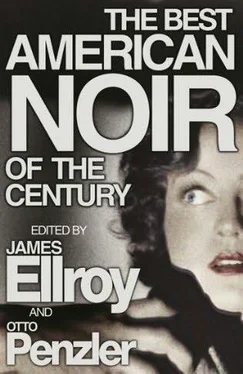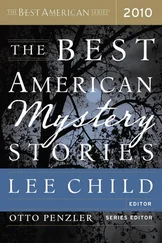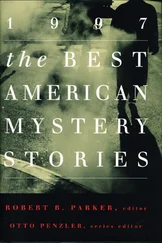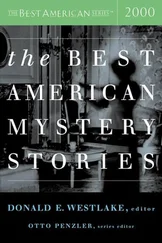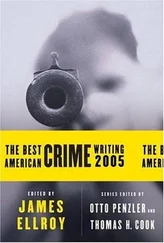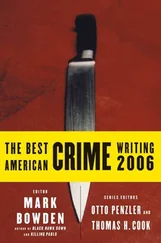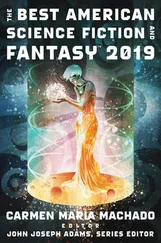“Of course, we’ve got hot water! Don’t we always have? Why do you always have to ask if — if—”
She couldn’t go through with it. Even as a gag — even someone who merely sounded and acted like he did — it was too much to bear.
“Y-you get out of here!” she quavered. “I don’t have to stand for this! I c-can’t stand it! I did it for fifteen years, and —”
“So what’s to get excited about?” he said. “Well, guess I’ll go splash the chassis.”
“Stop it! STOP IT!” Her screams filled the room …silent screams ripping through silence. “He’s —you’re dead! I know you are! You’re dead, and I don’t have to put up with you for another minute. And — and —!”
“Wouldn’t take no bets on that if I was you,” he said mildly. “Not with a broken neck like yours.”
He trudged off toward the bathroom, wherever the bathroom is in Eternity.
1968
CORNELL WOOLRICH
FOR THE REST OF HER LIFE
Cornell (George Hopley) Woolrich (1903-1968) was born in New York City but divided his early years between Latin America and Mexico, with his father, and New York, with his Manhattan socialite mother. While still an undergraduate at Columbia University, he wrote his first novel, a romance, Cover Charge (1926). Another romantic novel, Children of the Ritz (1927), quickly followed, and it won a $10,000 prize jointly offered by College Humor magazine and First National Pictures, which filmed it in 1929. Four more romantic novels, favorably compared to F. Scott Fitzgerald, followed. Woolrich had also begun to write short stories, and his first mystery was published in 1934. Most of his subsequent work (more than two hundred stories and sixteen novels) was in that genre. A reclusive alcoholic, he rarely left his hotel room for the last three decades of his life.
Arguably the greatest suspense writer of the twentieth century, Woolrich, under his own name and the pseudonyms William Irish and George Hopley, was able to construct plots that stretched credulity, especially in their dependence on coincidence, yet relentlessly gripped readers. He is noted for producing stories of the everyday gone wrong, as terrible things happen to ordinary people. More than twenty of his novels and stories were filmed, including The Leopard Man (1943), based on Black Alibi (1942), directed by Jacques Tourneur; Phantom Lady (1944), directed by Robert Siodmak; Rear Window (1954), based on “It Had to Be Murder” and directed by Alfred Hitchcock; and The Bride Wore Black (1967), directed by Francois Truffaut. More true of the literary works than the motion pictures (since Hollywood preferred happy endings), Woolrich was able to heighten suspense by being totally unpredictable, with readers never knowing if the suspense would be relieved or if it would be worse when the tale was ended.
“For the Rest of Her Life,” the last Woolrich story published during his lifetime, first appeared in the May 1968 issue of Ellery Queen’s Mystery Magazine, and was first collected in his Angels of Darkness (1978). It was made into a two-hour television movie in West Germany in 1974, directed and adapted for the screen by Rainer Werner Fassbinder.
Their eyes met in Rome. On a street in Rome — the Via Piemonte.
He was coming down it, coming along toward her, when she first saw him. She didn’t know it but he was also coming into her life, into her destiny — bringing what was meant to be.
Every life is a mystery. And every story of every life is a mystery. But it is not what happens that is the mystery. It is whether it has to happen no matter what, whether it is ordered and ordained, fixed and fated, or whether it can be missed, avoided, circumvented, passed by; that is the mystery.
If she had not come along the Via Piemonte that day, would it still have happened? If she had come along the Via Piemonte that day, but ten minutes later than she did, would it still have happened? Therein lies the real mystery. And no one ever knows, and no one ever will.
As their eyes met, they held. For just a heartbeat.
He wasn’t cheap. He wasn’t sidewalk riffraff. His clothes were good clothes, and his air was a good air.
He was a personable-looking man. First your eye said: he’s not young anymore, he’s not a boy anymore. Then your eye said: but he’s not old. There was something of youth hovering over and about him, and yet refusing to land in any one particular place. As though it were about to take off and leave him. Yet not quite that, either. More as though it had never fully been there in the first place. In short, the impression it was, was agelessness. Not young, not old, not callow, not mature — but ageless. Thirty-six looking fifty-six, or fifty-six looking thirty-six, but which it was you could not say.
Their eyes met — and held. For just a heartbeat.
Then they passed one another by, on the Via Piemonte, but without any turn of their heads to prolong the look.
I wonder who that was, she thought.
What he thought couldn’t be known — at least, not by her.
Three nights later they met again, at a party the friend she was staying with took her to.
He came over to her, and she said, “I’ve seen you before. I passed you on Monday on the Via Piemonte. At about four in the afternoon.”
“I remember you, too,” he said. “I noticed you that day, going by.”
I wonder why we remember each other like that, she mused; I’ve passed dozens, hundreds of other people since, and he must have too. I don’t remember any of them.
“I’m Mark Ramsey,” he said.
“I’m Linda Harris.”
An attachment grew up. What is an attachment? It is the most difficult of all the human interrelationships to explain, because it is the vaguest, the most impalpable. It has all the good points of love, and none of its drawbacks. No jealousy, no quarrels, no greed to possess, no fear of losing possession, no hatred (which is very much a part of love), no surge of passion, and no hangover afterward. It never reaches the heights, and it never reaches the depths.
As a rule it comes on subtly. As theirs did. As a rule the two involved are not even aware of it at first. As they were not. As a rule it only becomes noticeable when it is interrupted in some way, or broken off by circumstances. As theirs was. In other words, its presence only becomes known in its absence. It is only missed after it stops. While it is still going on, little thought is given to it, because little thought needs to be.
It is pleasant to meet, it is pleasant to be together. To put your shopping packages down on a little wire-backed chair at a little table at a sidewalk cafe, and sit down and have a vermouth with someone who has been waiting there for you. And will be waiting there again tomorrow afternoon. Same time, same table, same sidewalk cafe. Or to watch Italian youth going through the gyrations of the latest dance craze in some inexpensive indigenous night-place — while you, who come from the country where the dance originated, only get up to do a sedate fox trot. It is even pleasant to part, because this simply means preparing the way for the next meeting.
One long continuous being-together, even in a love affair, might make the thing wilt. In an attachment it would surely kill the thing off altogether. But to meet, to part, then to meet again in a few days, keeps the thing going, encourages it to flower.
And yet it requires a certain amount of vanity, as love does: a desire to please, to look one’s best, to elicit compliments. It inspires a certain amount of flirtation, for the two are of opposite sex. A wink of understanding over the rim of a raised glass, a low-voiced confidential aside about something and the smile of intimacy that answers it, a small impromptu gift — a necktie on the one part because of an accidental spill on the one he was wearing, or of a small bunch of flowers on the other part because of the color of the dress she has on.
Читать дальше
Конец ознакомительного отрывка
Купить книгу
